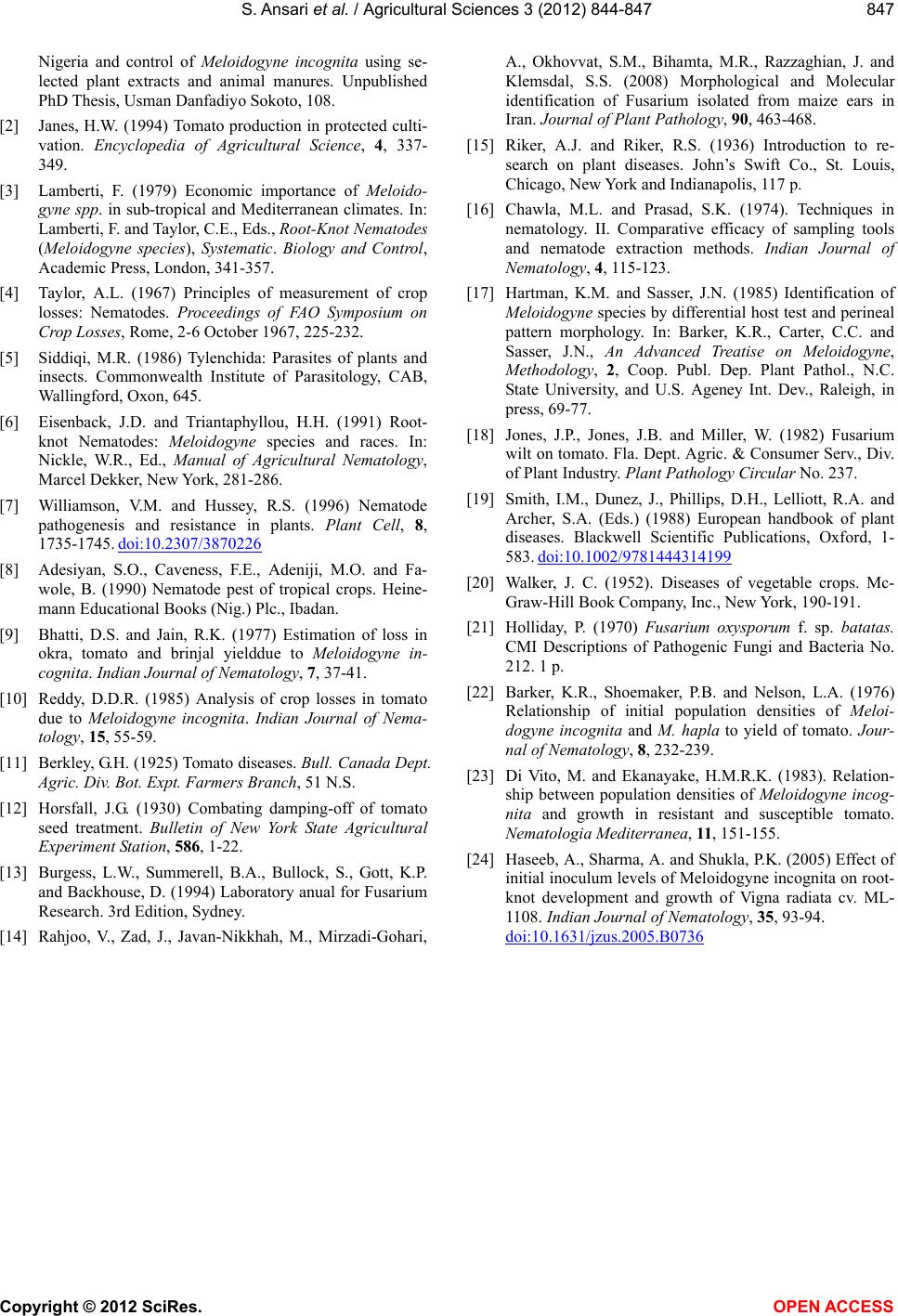
S. Ansari et al. / Agricultural Sciences 3 (2012) 844-847 847
Nigeria and control of Meloidogyne incognita using se-
lected plant extracts and animal manures. Unpublished
PhD Thesis, Usman Danfadiyo Sokoto, 108.
[2] Janes, H.W. (1994) Tomato production in protected culti-
vation. Encyclopedia of Agricultural Science, 4, 337-
349.
[3] Lamberti, F. (1979) Economic importance of Meloido-
gyne spp. in sub-tropical and Mediterranean climates. In:
Lamberti, F. and Taylor, C.E., Eds., Root-Knot Nematodes
(Meloidogyne species), Systematic. Biology and Control,
Academic Press, London, 341-357.
[4] Taylor, A.L. (1967) Principles of measurement of crop
losses: Nematodes. Proceedings of FAO Symposium on
Crop Losses, Rome, 2-6 October 1967, 225-232.
[5] Siddiqi, M.R. (1986) Tylenchida: Parasites of plants and
insects. Commonwealth Institute of Parasitology, CAB,
Wallingford, Oxon, 645.
[6] Eisenback, J.D. and Triantaphyllou, H.H. (1991) Root-
knot Nematodes: Meloidogyne species and races. In:
Nickle, W.R., Ed., Manual of Agricultural Nematology,
Marcel Dekker, New York, 281-286.
[7] Williamson, V.M. and Hussey, R.S. (1996) Nematode
pathogenesis and resistance in plants. Plant Cell, 8,
1735-1745. doi:10.2307/3870226
[8] Adesiyan, S.O., Caveness, F.E., Adeniji, M.O. and Fa-
wole, B. (1990) Nematode pest of tropical crops. Heine-
mann Educational Books (Nig.) Plc., Ibadan.
[9] Bhatti, D.S. and Jain, R.K. (1977) Estimation of loss in
okra, tomato and brinjal yielddue to Meloidogyne in-
cognita. Indian Journal of Nematology, 7, 37-41.
[10] Reddy, D.D.R. (1985) Analysis of crop losses in tomato
due to Meloidogyne incognita. Indian Journal of Nema-
tology, 15, 55-59.
[11] Berkley, G.H. (1925) Tomato diseases. Bull. Canada Dept.
Agric. Div. Bot. Expt. Farmers Branch, 51 N.S.
[12] Horsfall, J.G. (1930) Combating damping-off of tomato
seed treatment. Bulletin of New York State Agricultural
Experiment Station, 586, 1-22.
[13] Burgess, L.W., Summerell, B.A., Bullock, S., Gott, K.P.
and Backhouse, D. (1994) Laboratory anual for Fusarium
Research. 3rd Edition, Sydney.
[14] Rahjoo, V., Zad, J., Javan-Nikkhah, M., Mirzadi-Gohari,
A., Okhovvat, S.M., Bihamta, M.R., Razzaghian, J. and
Klemsdal, S.S. (2008) Morphological and Molecular
identification of Fusarium isolated from maize ears in
Iran. Journal of Plant Pathology, 90, 463-468.
[15] Riker, A.J. and Riker, R.S. (1936) Introduction to re-
search on plant diseases. John’s Swift Co., St. Louis,
Chicago, New York and Indianapolis, 117 p.
[16] Chawla, M.L. and Prasad, S.K. (1974). Techniques in
nematology. II. Comparative efficacy of sampling tools
and nematode extraction methods. Indian Journal of
Nematology, 4, 115-123.
[17] Hartman, K.M. and Sasser, J.N. (1985) Identification of
Meloidogyne species by differential host test and perineal
pattern morphology. In: Barker, K.R., Carter, C.C. and
Sasser, J.N., An Advanced Treatise on Meloidogyne,
Methodology, 2, Coop. Publ. Dep. Plant Pathol., N.C.
State University, and U.S. Ageney Int. Dev., Raleigh, in
press, 69-77.
[18] Jones, J.P., Jones, J.B. and Miller, W. (1982) Fusarium
wilt on tomato. Fla. Dept. Agric. & Consumer Serv., Div.
of Plant Industry. Plant Pathology Circular No. 237.
[19] Smith, I.M., Dunez, J., Phillips, D.H., Lelliott, R.A. and
Archer, S.A. (Eds.) (1988) European handbook of plant
diseases. Blackwell Scientific Publications, Oxford, 1-
583. doi:10.1002/9781444314199
[20] Walker, J. C. (1952). Diseases of vegetable crops. Mc-
Graw-Hill Book Company, Inc., New York, 190-191.
[21] Holliday, P. (1970) Fusarium oxysporum f. sp. batatas.
CMI Descriptions of Pathogenic Fungi and Bacteria No.
212. 1 p.
[22] Barker, K.R., Shoemaker, P.B. and Nelson, L.A. (1976)
Relationship of initial population densities of Meloi-
dogyne incognita and M. hapla to yield of tomato. Jour-
nal of Nematology, 8, 232-239.
[23] Di Vito, M. and Ekanayake, H.M.R.K. (1983). Relation-
ship between population densities of Meloidogyne incog-
nita and growth in resistant and susceptible tomato.
Nematologia Mediterranea, 11 , 151-155.
[24] Haseeb, A., Sharma, A. and Shukla, P.K. (2005) Effect of
initial inoculum levels of Meloidogyne incognita on root-
knot development and growth of Vigna radiata cv. ML-
1108. Indian Journal of Nematology, 35, 93-94.
doi:10.1631/jzus.2005.B0736
Copyright © 2012 SciRes. OPEN ACCESS